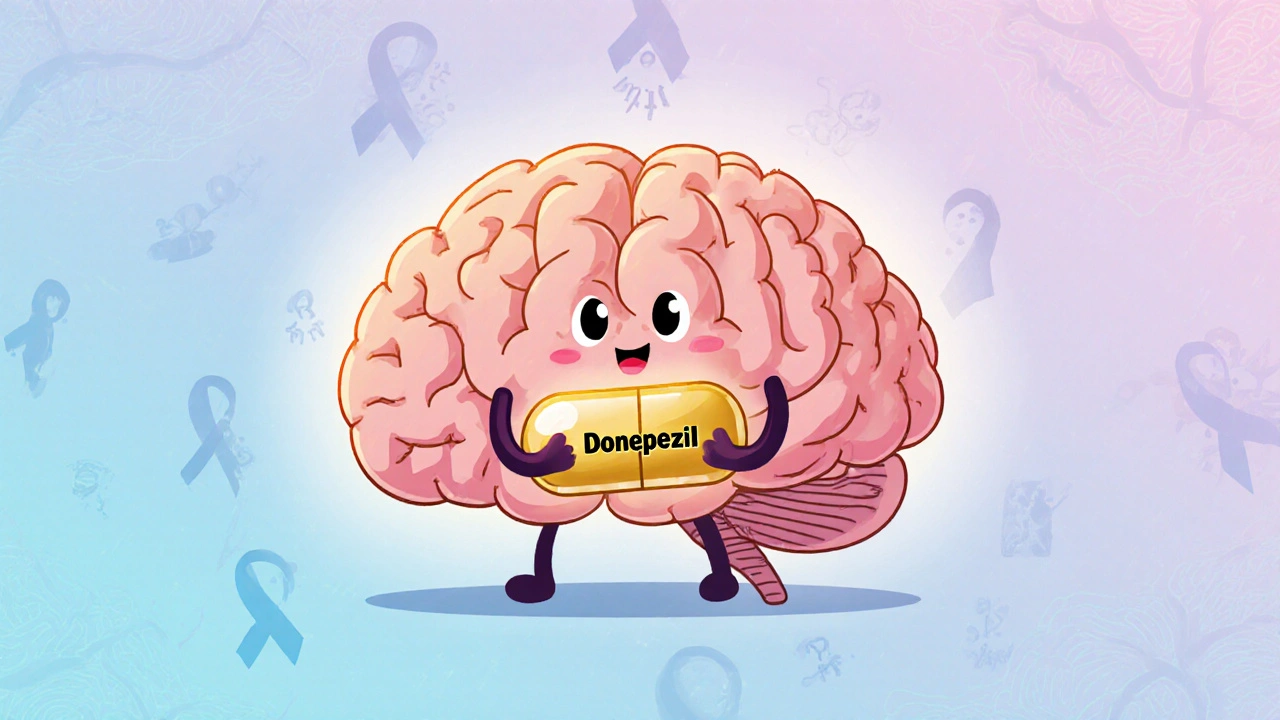When most people hear donepezil, they picture the pill that’s been a mainstay for Alzheimer’s disease for decades. But what if that same drug could help with Parkinson’s, Lewy body dementia, or even Huntington’s disease? Researchers are quietly testing the idea, and the early signals are worth a closer look.
What Donepezil Actually Is
Donepezil is a reversible acetylcholinesterase inhibitor that boosts the level of the neurotransmitter acetylcholine in the brain. By slowing the breakdown of acetylcholine, it aims to improve communication between neurons that are otherwise losing their edge. Approved in 1996 for mild‑to‑moderate Alzheimer’s, it’s become a household name in neurology clinics worldwide.
Why Look Beyond Alzheimer’s?
The brain’s cholinergic system isn’t just a casualty in Alzheimer’s; it also plays a part in several other neurodegenerative conditions. When researchers map out the overlap, a pattern emerges: many disorders involve reduced acetylcholine, disrupted synaptic plasticity, and inflammation that could, in theory, respond to a boost in cholinergic signaling.
Key Neurodegenerative Disorders Under the Lens
Neurodegenerative disorders are a group of diseases marked by the progressive loss of structure or function of neurons, often leading to cognitive, motor, or psychiatric decline. Below are the conditions receiving the most attention in recent donepezil studies.
- Parkinson’s disease (PD): Primarily a movement disorder, but up to 30% of patients develop cognitive impairment that resembles early Alzheimer’s.
- Lewy body dementia (LBD): Shares hallmarks with both Alzheimer’s and Parkinson’s, including fluctuating attention and visual hallucinations.
- Frontotemporal dementia (FTD): Characterized by changes in personality and language, with less known about cholinergic involvement.
- Huntington’s disease (HD): A genetic disorder causing chorea and psychiatric symptoms; some early trials suggest cholinergic drugs could ease mood swings.
What the Science Says So Far
Several small‑scale trials and observational studies have tried to answer the “can” question. Here’s a quick snapshot of the findings.
| Condition | Study Design | Primary Outcome | Key Result |
|---|---|---|---|
| Parkinson’s disease dementia | Randomized, double‑blind, 12‑week | MMSE improvement | Mean increase of 2.1 points vs. placebo |
| Lewy body dementia | Open‑label, 24‑week | Daily living activities (ADL) score | 15% reduction in ADL decline |
| Frontotemporal dementia | Pilot, 8‑week | Behavioral Rating Scale | No statistically significant change |
| Huntington’s disease | Phase II, 16‑week | Depression Inventory | Modest 10% improvement vs. baseline |
Notice the mixed bag: strong signals in Parkinson’s disease dementia and LBD, but a weaker response in FTD. The pattern suggests that donepezil’s benefit may hinge on how much a disorder relies on the cholinergic system.
Mechanisms That Might Explain the Benefits
Three biological pathways keep coming up in the literature:
- Acetylcholine restoration: By inhibiting acetylcholinesterase, donepezil raises synaptic acetylcholine, which can improve attention and memory.
- Neuroinflammation modulation: Some animal studies show donzepil reduces microglial activation, which may slow neuronal loss.
- Synaptic plasticity support: Increased cholinergic signaling can enhance long‑term potentiation, a cellular correlate of learning.
When those mechanisms line up with a disorder’s pathology, the drug is more likely to make a noticeable difference.

Safety Profile - What to Watch Out For
Donepezil is generally well‑tolerated in older adults, but side‑effects still pop up:
- Nausea or vomiting (≈10% of users)
- Diarrhea
- Insomnia or vivid dreams
- Bradycardia - especially important for Parkinson’s patients on dopamine agonists
Because many neurodegenerative diseases already involve autonomic dysfunction, clinicians usually start at a low dose (5 mg daily) and titrate up to 10 mg after four weeks, monitoring heart rate and GI tolerance.
Practical Guidance for Clinicians
If you’re considering off‑label donepezil for a patient with, say, Parkinson’s disease dementia, here’s a quick checklist:
- Confirm that cholinergic deficit is part of the clinical picture (e.g., low attention scores, prominent REM sleep behavior disorder).
- Rule out contraindications: severe sinus node dysfunction, active peptic ulcer, or concurrent use of strong CYP3A4 inhibitors.
- Start at 5 mg daily; assess tolerance after two weeks.
- Schedule cognitive testing (MoCA or MMSE) at baseline and after 8‑12 weeks.
- Document any changes in motor symptoms; dopaminergic drugs can sometimes interact.
Most neurologists find that any improvement, even a modest 1‑2 point bump on the MMSE, can translate into better day‑to‑day functioning for patients and caregivers.
Future Directions - Ongoing Trials
As of October 2025, three Phase III trials are recruiting:
- DIANE‑PD: 600 participants with Parkinson’s disease dementia, 24‑month primary endpoint is change in the Dementia Rating Scale.
- LBD‑PLUS: Multicenter study looking at donepezil combined with memantine for Lewy body dementia.
- HUN‑CHOL: Examines mood and motor outcomes in Huntington’s disease patients already on tetrabenazine.
Results won’t be out until late 2026, but the very fact that industry sponsors are funding large trials signals confidence in the drug’s repurposing potential.
Bottom Line - Should You Hope for a New Use?
Donepezil isn’t a miracle cure for every neurodegenerative disease, but the evidence stack is growing for conditions where cholinergic loss plays a clear role. If you’re a patient or caregiver, ask your neurologist whether a trial of donepezil makes sense for your specific symptoms. If you’re a clinician, weigh the modest benefits against the well‑known safety profile and consider enrolling eligible patients in ongoing trials.

Can donepezil be used for Parkinson’s disease dementia?
Yes. Small randomized trials have shown a mean 2‑point improvement on the MMSE after 12 weeks, and larger Phase III studies are underway to confirm the finding.
Why doesn’t donepezil work well for frontotemporal dementia?
FTD’s pathology centers on tau or TDP‑43 protein aggregates, not on cholinergic deficits, so boosting acetylcholine doesn’t address the core disease process.
What are the main side‑effects to watch for?
Nausea, diarrhea, insomnia, vivid dreams, and rare bradycardia. Start low, titrate slowly, and monitor heart rate especially in patients on other cardiac meds.
Is donepezil affordable for off‑label use?
Generic versions cost around $0.10‑$0.15 per tablet in the U.S., making it a low‑cost option for many health systems, though insurance coverage varies when prescribed off‑label.
Where can patients find clinical trials?
Check ClinicalTrials.gov using keywords like “donepezil” and the specific disorder (e.g., Parkinson’s disease dementia). Major academic centers in Melbourne, Sydney, and Brisbane are recruiting for the DIANE‑PD trial.


15 Comments
sarah basarya
Alright, so we’re suddenly putting donepezil on a shelf of “miracle pills” for everything from Parkinson’s to Huntington’s? Honestly, it feels like we’re slapping a Band-Aid on a broken engine. The drug’s modest boost in acetylcholine is great for Alzheimer’s, but expecting it to fix motor symptoms is a stretch. Still, the early data is intriguing enough to keep an eye on.
Leah Ackerson
💭 The real question is whether we’re chasing a false hope or finally uncovering a hidden gem. If the cholinergic decline truly drives cognitive fog in Parkinson’s, then why not give it a fair shot? Yet, the evidence is still a patchwork, and we must tread carefully. 🤷♀️
abidemi adekitan
First off, kudos to the researchers who are willing to look beyond the traditional boundaries of drug indication; repurposing is a clever way to accelerate therapeutic options without reinventing the wheel. The cholinergic hypothesis, while not novel, offers a unifying thread that binds a spectrum of neurodegenerative disorders under a common mechanistic umbrella. In Parkinson’s disease dementia, for instance, the loss of basal forebrain projections mirrors the deficits seen in Alzheimer’s, and a modest increase in synaptic acetylcholine can translate into measurable gains on the MMSE. The same logic extends to Lewy body dementia, where fluctuations in attention and vivid hallucinations may mask an underlying cholinergic shortfall, making donepezil a plausible adjunct. Conversely, frontotemporal dementia throws a wrench in the works because its pathology revolves around tau and TDP‑43 aggregates, which are largely indifferent to cholinergic modulation; thus, the drug’s impact there is predictably muted. Huntington’s disease adds another layer of complexity; the choreic movements are driven by striatal degeneration, yet patients also suffer from mood lability, a domain where cholinergic agents have shown subtle benefits. The safety profile of donepezil, characterized by gastrointestinal upset and occasional bradycardia, is generally acceptable, especially when titrated from 5 mg to 10 mg in a stepwise fashion. However, clinicians must remain vigilant in populations already prone to autonomic dysfunction, such as Parkinson’s patients on dopaminergic therapies. From a pharmacoeconomic perspective, the generic price tag of a few cents per tablet makes wide‑scale off‑label use an attractive proposition for strained health systems. That said, the heterogeneity of trial designs-from open‑label extensions to double‑blind randomized arms-makes cross‑study comparisons treacherous. What we really need are head‑to‑head trials that control for baseline cholinergic biomarkers, perhaps using PET imaging to stratify responders. Until then, the current evidence serves more as a hypothesis‑generating platform than a definitive guideline. Still, for a clinician faced with a patient whose cognitive decline is slipping through the cracks, a low‑risk trial of donepezil may be justified. In the end, it’s a delicate balancing act between optimism for a modest gain and the pragmatism of unwarranted polypharmacy. Let’s keep a close eye on the upcoming Phase III data; the outcomes could reshape our prescribing habits across multiple disease spectrums.
Barbara Ventura
Wow-so many studies, so much data, and yet the conversation keeps circling back to the same core questions, right? The enthusiasm is palpable, the caution is warranted, and the potential is undeniable; we just need clearer guidelines.
laura balfour
Honestly, it’s like watching a slow‑motion car crash-exciting until you realize the brakes aren’t even on! The evidence for Parkinson’s and LBD is promising, but the FTD results are a total bust. I mean, how many times can we keep pushing a drug that simply doesn’t fit the pathology? Still, let’s not write it off before the big trials roll out-maybe the next wave will surprise us.
Ramesh Kumar
Just to add a bit of context, the cholinergic system isn’t isolated; it interacts with dopaminergic and glutamatergic pathways, which could explain some of the mixed outcomes we see across disorders. If you look at the neurochemical maps, boosting acetylcholine might indirectly modulate other neurotransmitters, offering a broader neuroprotective effect.
asha aurell
Donepezil works better for PD dementia than for FTD.
Abbey Travis
That’s a fair point-starting low and monitoring side‑effects is key, especially for patients juggling multiple meds. It’s great that you highlighted the practical checklist; clinicians appreciate that concrete guidance.
ahmed ali
Look, I get the hype around "repurposing" as if it’s a silver bullet that magically solves all our problems, but let’s be real: donepezil is not a one‑size‑fits‑all solution, and treating it like some miracle cure is a dangerous oversimplification. The data from these small‑scale trials are often underpowered, and the open‑label designs are riddled with bias-people tend to see what they want to see. Plus, there’s the issue of dosage; many of these studies use the same 10 mg dose that works for Alzheimer’s, ignoring the fact that the pharmacodynamics might differ dramatically in a Parkinsonian brain. Not to mention the side‑effects-nausea, vivid dreams, bradycardia-these aren’t trivial, especially in the elderly who already have fragile autonomic systems. And while the cost is low, the hidden costs in terms of polypharmacy, monitoring, and potential drug‑drug interactions can add up quickly. So before we start writing prescriptions for every patient with a neurodegenerative condition, we need larger, double‑blind trials with rigorous endpoints. Until then, I’d advise caution and a healthy dose of skepticism.
Deanna Williamson
While the enthusiasm is understandable, the reality is that many of these “promising” results are nothing more than statistical noise dressed up as breakthrough. Clinicians need to stop chasing after hype and start demanding robust, reproducible data before adding yet another pill to already cluttered regimens.
Miracle Zona Ikhlas
Great summary-definitely worth discussing with patients who are looking for any potential benefit.
naoki doe
Honestly, I think we’re missing the bigger picture here: it’s not just about whether donepezil works, but why we keep relying on the same old drugs instead of investing in novel approaches that could target disease mechanisms more directly. Maybe it’s time to question the entire paradigm of repurposing as a default strategy.
Carolyn Cameron
In summation, whilst the extant literature furnishes preliminary indications of efficacy within select cholinergically compromised pathologies, it would be intellectually negligent to extrapolate these findings indiscriminately across the heterogeneous spectrum of neurodegenerative disorders without further empirical substantiation.
Joe Langner
Even a modest two‑point bump on the MMSE can translate into a brighter day for a patient and their family, reminding us that incremental gains are still victories in the long, arduous battle against neurodegeneration.
Ben Durham
From a global health standpoint, the affordability and wide availability of generic donepezil could make it a valuable tool in low‑resource settings, provided that clinicians adhere to careful patient selection and monitoring protocols.